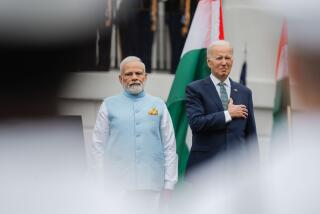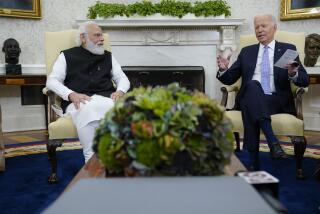On the Move, Not a Third World Renegade : India: A closer relationship can only benefit the U.S. as the prosperous giant becomes a nation to be reckoned with.
- Share via
Voters in India, the world’s largest democracy, have started three days of balloting. Under the leadership of Prime Minister Rajiv Gandhi, there has been an increase in economic prosperity and a gradual improvement in U.S.-Indian relations. But much more needs to be done.
Like it or not, that huge country is edging its way into the big league and, while there are reasons for its neighbors to worry, India’s record is light years better than the other Asian behemoth, China, as the savage killings in Tian An Men Square this past summer demonstrated.
India is going through an unprecedented period of economic growth, an awakening similar to the emergence of the United States as a world power at the end of the 19th Century. With a middle class of 150 million, who, according to the British journal The Economist, enjoy a standard of living similar to that of north Europeans in the early 1960s, India is indeed on the move. Like any large power, India has its share of social problems, as 10 minutes in Bombay will attest, but there is something vibrant and dynamic happening to the society.
Why haven’t we enjoyed a better relationship with India? In spite of a common language and system of government--and increasingly similar attitudes toward the private sector--India does not have a special status in American domestic politics like Britain, France, Japan, the Philippines and Israel. Strategic issues tend to dominate the U.S.-Indian agenda now as in the past.
The ups and downs in U.S.-India relations began in the 1950s. Pakistan was a U.S. ally, while India was nonaligned and therefore untrustworthy. During the early 1960s, the Sino-Soviet rift and the India-China border war drew the United States and India into a closer understanding, with the United States providing military assistance to India. The 1965 Indo-Pakistan war saw a severe rupture in U.S. relations with both countries because of the arms embargo that Washington and London imposed on them during the war. That trauma caused India and Pakistan to strengthen their military ties with the Soviet Union and China, respectively. In 1971, the United States further alienated India with the “tilt” toward Pakistan during the war over East Pakistan.
New Delhi’s unwillingness to condemn the Soviet invasion of Afghanistan confirmed American suspicions of Indian trouble-making. Because of the close ties between India and the Soviet Union, the United States has been wary of approving the sale of high-tech items for fear that they might end up in Moscow’s hands. Up until 1985 it was difficult to persuade the Pentagon to pursue a more active role in helping India develop its technological base.
The ascension of Rajiv Gandhi as prime minister after his mother’s assassination in October, 1984, led to a more relaxed attitude toward technical ties. In addition to an agreement on the sale of a laser gyroscope, there have been discussions between the Northrop Corp. and Indian officials concerning the co-production of F-5 trainer aircraft.
The United States has also agreed to sell India a supercomputer to assist in weather forecasting, but this is now under scrutiny because of two other strategic problems: nuclear weapons and India’s surface-to-surface missile program.
The United States has little leverage over India’s nuclear weapons, and American homilies about the dangers of the spread of nuclear weapons do not sit well with the Indian elite, who are fond of pointing out the inconsistencies and bias of Washington’s statements on non-proliferation. For years, the United States has had virtually nothing to say about Israel’s or China’s nuclear capabilities, even though Israel and, to a lesser extent, China, receive U.S. military aid.
The same problems apply to the missile issue. India’s missile program is part of its determination to join the nuclear club. Efforts by the United States to stop India from developing high-technology “know-all” will not halt the program, merely slow it down. Some would argue that this would be a useful step, but in reality the United States and India have more important mutual interests in arms control. Efforts to ensure that Indian and Pakistani nuclear-weapon capabilities are not exported to neighbors, especially those in southwest Asia, must be at the top of the list.
We need to work with India as a partner to solve the growing global nightmares of environmental pollution, population dynamics and international terrorism, as well as weapons proliferation. The time has come for the United States to take India more seriously and treat it as an emerging great power, not as some Third World renegade.
More to Read
Sign up for Essential California
The most important California stories and recommendations in your inbox every morning.
You may occasionally receive promotional content from the Los Angeles Times.













